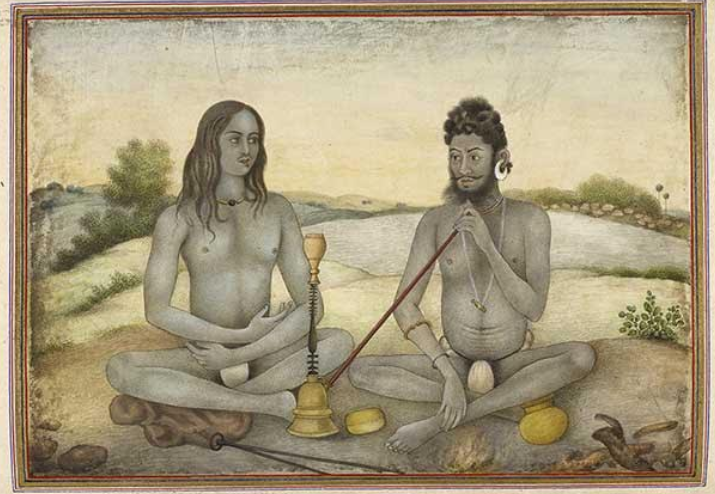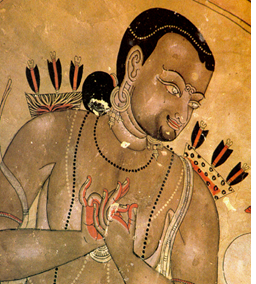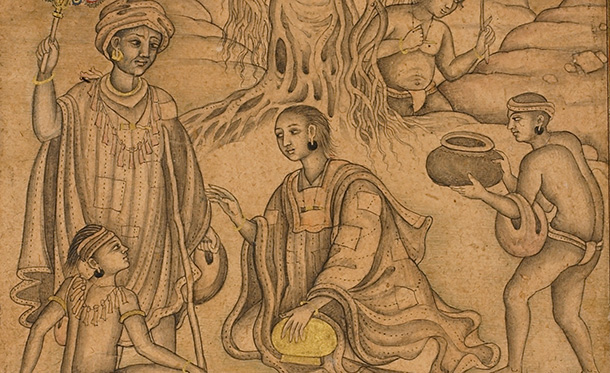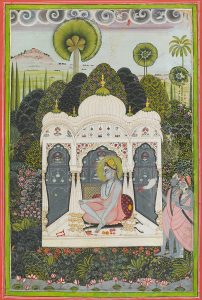During the medieval era, roughly between the 9th and 13th century, there arose a group of spiritual adepts known popularly as the Nath Siddhas. Some accounts believe they were from North West India, but there is evidence of their presence in Eastern India as well, as also in the current state of Maharashtra. Given the lack of authentic historical documents, as per scholars, pertaining to the true extent of the Nath cult, we are left to rely more on popular stories and colloquial narratives that have come down to us from that era.
By most accounts, the Naths were a heterodox tradition of siddhas – accomplished yogis – whose path assimilated various aspects of Tantra and Hatha Yoga. The Sanskrit word “Natha” literally means “Lord” or “protector”. There appears to have been close links between the Hindu Naths and the Siddhas of the Vajrayana tradition. Particularly, during the Pala era of Bengal, Buddhist commentator Taranath notes that the presence of 84 Siddhacharyas, who were Tantric experts and imparted spiritual knowledge to the ordinary people. They were reputed for their supernatural powers, or siddhis, and specially 8 exceptional siddhis known as Aṇimā, Mahima, Garima, Laghima, Prāpti, Prākāmya, Iṣiṭva, and Vaśitva. Apart from Taranath’s documentation, further details about their lives also come down to us from other Tibetan sources like Gos lo-tsa-ba, Sumpa-khan-po, and Bu-ston. Following is a list of the names we find from these sources:
Luhi, Lila, Viru, Dombi, Sabara, Saraha (Rahulabhadra), Kankali, Mina, Goraksha, Caurangi, Vina, Santi, Tanti, Carmari, Khadga, Nagarjuna, Kanha, Kanari Thangana, Naro, Sali, Tilo, Chatra, Bhadra, Dvikhandi, Ajogi, Kada, Dhobi, Kankana, Kampala, Gingi, Bhade, Tandhi, Kukkuri, Cujbi, Dharma, Mahi, Acinti, Bhalaha, Nalina, Bhusuku, Indrabhuti, Megha, Kuthali, Karmara, Jalandhara, Rahula, Garbhari, Dhakari, Jogi, Celuka, Sundari, Lunacka, Nirguna, Jayananda, Carpati, Campaka, Bhikhana, Kumari, Cavari, Manibhadra, Mekhala, Mankhala, Kalakala, Kanthali, Dhahuli, Udhali, Kapala, Kila, Sagara, Sarvabhaksa, Nagabodhi, Darika, Putuli, Upanaha, Kokila, Ananga, Laksminkara, Samundra and Bhali.
Some of these like Manibhadra, Mekhala and Mankhala were female siddhas. Taranath further mentions that one lineage of Siddhas started with Saraha or Rahulabhadra, author of Buddhakapala Tantra, followed by Luipada, author of Yoginisamcarya, Kambala and Padmavajra, Krshna, Lilavajra, author of Krsnayamari-tantra, Gambhiravajra, Kukkuri, etc. Other texts give the succession of Siddhas as Rahula, Nagarjuna, Siddasabari, Luipa, Dombi, Tilopa, Naropa, Dombi, and Kusalibhadra. In the Hindu tradition 9 among these 84 were given special status and considered as a unit, or Navanathas: Matsyendra-Nath, Gorakshanath, Jalandharanath, Kanifanath, Charpatinath, Naganath, Bhartrinath, Revannath, Gahaninath.
Most of these Naths and Siddhas belonged to lower sections of society, were engaged in domestic and secular professions, while practicing and preaching spirituality to others. This is apparent from the names of Dombi, Sabari, Tanti, Camari, etc., who all belonged to professions of corpse-carriers in cremation grounds, or leather-workers, washermen, oilmen, tailors, fishermen, woodcutters and the like. Saraha or Rahulabhadra, who was the teacher of Nagarjuna, as per some scholars, was an arrow-maker by profession, while Jalandhara or Hadipa worked as a sweeper in the court of queen Mainamati of Bengal. The system of the Naths was extremely heterodox and kept itself away from the paths of mainstream religion, though it borrowed heavily from a liberal interpretation of Saiva, Shakta, Vaishnava and Buddhist texts.
Lineage, Philosophy and Practice
Some scholars believe that the Nath tradition may have originated in the foothills of the Himalayas and the extreme climatic conditions in that area could have contributed to their proclivity towards siddhis of the physical body. But irrespective of their place of origin, their influence clearly spread across India from Maharashtra and Gujarat in the West, to Bengal and Assam in the East, and deep inside South India as well. It is also possible that some of the Siddha lineages were parallel developments. The Rasesvara Siddhas of Maharashtra area and the Maheswara Siddha tradition of the South often mention the Naths and Siddhacharyas from the North. Similarly, some of the Nath literature from the North refer to the alchemical mysteries of Raseswaras, especially with regards to the usage of mercury in the transformation of the physical body. In a text called Viramahesvara from the 12th century, there is a reference to Nath Siddha Goraksha meeting a Maheshwara Siddha around the Tungabhadra region, who imparted secret knowledge to Goraksha. In various places in the North, the Naths are referred to as Kan-phata-yogis because of a particular kundala that they wear in their ears, driven through the cartilage. Madhava in his 14th century Sarvadarsanasamgraha opines that alchemy is a branch of Hatha-Yoga of the Naths. The Shakti pithas were the main place of pilgrimage and initiation. An old Bengali book refers to a journey of Mastyendranath and Gorakshanath from Kamakhya peetha to Hinglaj, where the later, on the orders of his Guru, was made to meditate inside a cave, where animal sacrifices used to happen, until he had a vision of the Goddess Hinglaj and was blessed with clairvoyance. Probably the most revered figure to the Naths was Adinath or the first among them. Some texts equate Adinath with Shiva, others with Dattatreya, while a majority seems to view Adinath as the source or father of Shiva. The lore goes that Adinath’s first son and disciple was Lord Shiva, who became an immortal god by the power of his mahajnana. Shiva then took his wife Chandi or Gauri into the middle of an ocean and imparted the knowledge of the Naths to her. While this discourse was going on, Minanatha or Matsyendranatha heard the conversation from inside the womb of a fish and learned the Nath practices. Another text mentions that originally there were only 5 Nath yogis – Matsyendra, who was born from the navel of Adinath, Goraksha, born from Adinath’s head, Hadi-pa or Jalandhara, born from Adinath’s bones, Kanu-pa or Kanifa or Krsnanath, born from Adinath’s ears, and Caurangi from Adinath’s legs.
The Siddhacharya culture was further divided into five kulas or clans: Dombi, Nati, Rajaki, Candali, and Brahmani, which were symbolic of the five types of Shakti given high prominence among the Kaulas. The Naths also had many similarities with the Sahajiyas, and both these groups are believed to have reached exceptional proficiency in sadhanas of the human body. Some texts pertaining to the Naths and Siddhacharyas mention that there are 32 special nerves in the body through which the Shakti flows from its origin below the navel. Here an interesting point must be noted. While today the idea is ubiquitous that the Kundalini Shakti arises from the base of the spinal cord, it is more likely an effect of some texts of Tantra and Yoga that were translated during the 18th century, which held this particular view on the topic. There is however other texts, lesser known, both in the Hathayogic and the Tantric tradition, both inside Hinduism and in Tibetan Buddhism, more in the later than the former, where the source of the Kundalini is mentioned as the navel, or just above the navel, in a human being. This was the central point from which the human ego is believed to function, and when this energy was transformed into what is known as the Kundalini, an awakening was felt near or just above the navel and an upsurge of energy move upwards to whatever purpose the seeker directed it for.
So it is not surprising that the Siddhacharya and Natha literature mention the navel area as the source of the energy which then flows, or can flow into 32 special ethereal nadis inside the subtle body of a human being. Some of these nadis were: lalana, ramana, rasana avadhuti, pravana, krsnarupini, samanya, pavaki, sumana kamini, etc. Of these lalana, rasana and avadhuti were later on became more popularly known as ida, pingala and susumna nadi – the fundamental trio of Kundalini sadhana. Not only this, there were also many secret centers where multiple nadis crisscrossed and these became known as Chakras. A seeker in the Nath philosophy after awakening his Kundalini from the navel could keep it stationed in one or multiple of these chakras by ritualized meditative processes and thus gain various occult and supernatural abilities. Among the numerous such chakras, the highest resort for Shakti was considered to be the center above the head, mahasukhasthana, the place of greatest bliss! In later and more popular texts this became known by its alternate name, sahasrar or the center of the thousand-petaled lotus. The various Tantrica peethas, specially the four most prominent – Uddiyana, Jalandhara, Purnagiri and Kamarupa – were also equated with various chakras inside the subtle body of a sadhaka and accordingly sadhanas were designed for harnessing the special energy of such places. Eventually one of the fundamental aims was to attain a state of effortless existence and causeless bliss known as sahaja, where the aspirant has the feeling of non-dualism and sees all as a part of his own spiritual Self. While the Naths and the 84 Siddhacharyas may not have created a formidable body of philosophical commentary and polemics, – doctrinal purity seems to have been the least of their concerns – it is undeniable that they too were advocates of practical Vedanta, attained through a process of Tantric and Hathayogic ritualism.
Till this point we find their ideas very similar to the doctrines of Advaita Vedanta, but not beyond this. For merely a feeling of inner bliss of the soul was not enough for them, the Naths and Siddhas also aimed to divinize the human body and lead an existence not at the mercy of a mechanical and brutish nature, but like a reflection of the Lord, Ishwara himself, stand above nature and direct its course, not in an egoistic human sense filled with effort and the consequent regret from failure, rather in the smooth, magical and simple way in which the Supreme does things in the Universe. In addition to the 6-chakra system of pure Tantrica texts like Sathachakra Nirupana, the Naths had recognized three additional chakras, as mentioned in the Gorakh-Vijaya. These 3 chakras were linked to three forms of Sunyata – Adi, Madhya and Antyah. Very little is known in today’s spiritual circles on these three chakras, except that they were linked to the stages developed post the realizing of the Mahasukhasthana or the thousand-petaled overhead lotus.
All stories of the Naths also contained heavy dosage of spiritual magic. Matsyendra was believed to have manifested dual bodies on various occasions, while Goraksha’s siddhi of Bhairava allowed him complete knowledge of different forms of yoga and unbeatable mastery in spiritual logic and polemics. Caurangi, it is believed, had regenerated his own limbs by a 12 year sadhana under his Guru’s instructions. A local folklore from western India, tells of an encounter between Jalandhara Natha – born in Bengal, but who roamed across North – and an evil magician where the former ends up transforming the later into a parrot. Jalandhara’s chief disciple Kanifa, according to Tibetan sources would fly in the air or invoke a preta inside a dead-body and sit on it while instructing his disciples. Whatever the truth in these stories, the general idea was that the Naths held many supernatural abilities and this was not in contradiction to their core philosophy or the way in which they defined the aims of their path. Not merely a feeling of liberation, or an escape into Moksha, but rather manifesting the powers of the Divine in this very lifetime while operating from a station of effortless, egoless ease. That to them was a true jivanmukta.
Sabar Tantra
The Naths were firm believers in the divine power of the Guru or preceptor, who initiated disciples into the path. While their core worship was of the formless often captured by the crisp terminology like Alakh Niranjan, Sunya, Anadi, etc. they had no theological or practical restrictions against doing sadhana of deities for various purposes, mundane or otherwise. In fact it is quite likely that the idea of using the power of a deity for practical benefits was championed by the Nath yogis and a reflection of the same can be found even today through the innumerable texts of Sabar Vidyas and Tantras available across North, East, West and central India, right from interior Maharashtra to rural Bengal. The Navnath Bhakisar from Maharashtra, a much later day text, contains stories of the 9 Naths and their journey, equating each of the Naths with 1/10 of the spiritual power of Krishna. It has many stories of Naths engaging in spiritual warfare with various devatas to establish their supremacy. While to a casual reader untrained in occult secrets of the Kundalini literature, these may sound blasphemous, the purport is most likely an attempt to convert into popular stories certain aspects of higher sadhana. Indeed some of the nadis described in the Nath literature are considered to be available to the rarest of rare seeker who has gone even beyond the realm of the deities, or at least has spiritualized himself to their extent, not only in a psychological sense of the Upanishadic Mahavakya, Aham Brahmasmi, but also in the physical and vital level of reality. Needless to say, that is no easy matter and for all practical purposes, far removed from the capability of most sadhakas in today’s world.
Since the cult of the Siddhas and Naths gave much greater prominence to practical spirituality rather than theory, they would conduct most of their discourses in local languages. This is best exemplified by the famous Maharashtrian Nath Siddha known as Jnaneshwara, who was a disciple of Nivruttinath, who in turn was a disciple of Ganahi Nath, whose Guru was Gorakshanath. Jnaneshwara was the first one to write a famous commentary on the Gita in a non-Sanskrit language, which holds a unique place in the history of Marathi literature, while acting as a core text of the Nath Sampradaya of Maharashtra. In Bengal, the Sahajiyas who were similar to the Naths composed the first caryapadas – a collection of spiritual poem – in proto-Bengali. In fact almost every single text of Sabar Tantra popular across the North is in local language. These texts contain very little or no philosophy but more like a compendium of practical sadhanas for specific gains. The only test of a Sabara prayoga is whether it works and how quickly it works. The percolation of these sadhanas became so far reaching that even some of the more orthodox Kaula sampradayas of the North started using Sabar vidyas for smaller aims. For example, one of the easiest uses of Sabar is to protect an area where a ritual is to be performed. This becomes particularly important given that many Tantric rituals are often conducted in places where there is a serious chance of attacks from ethereal entities and other non-corporeal forces with terrifying consequences. Siddhi of a Sabar vidya is much easier to achieve and apply, provided the exact instruction comes from a qualified source, than using more traditional methods. This also acts as a means of conserving energy because the final goal of spiritual uplift has to come from more standardized sadhanas, but to take care of peripheral and auxiliary matters, Sabar Tantra is the most reliable and quickest bet.
Though the original Nath tradition has almost declined or moved away from public, or as in the case of Maharashtra transformed into a kind of Vaishnavism, their methods and sadhanas are still widely practiced. It is quite likely that without the Nath yogis, much of the knowledge regarding Kundalini Yogas would never have come down to us. That is probably their most unique and far reaching contribution, for Kundalini is not a term we can find in Vedas or Upanishads or even the Gita; it comes to us from the Nath traditions and then gets incorporated in the Tantras.
May those legendary Nath Yogis and their teachings never be forgotten in this land!
Feature Image: http://www.asia.si.edu
Disclaimer: The facts and opinions expressed within this article are the personal opinions of the author. IndiaFacts does not assume any responsibility or liability for the accuracy, completeness, suitability, or validity of any information in this article.
Svechchachari is the pen name of a tantrik sadhaka, who wishes to remain anonymous so that he is able to express his opinions and share his experiences more freely through his writings.




